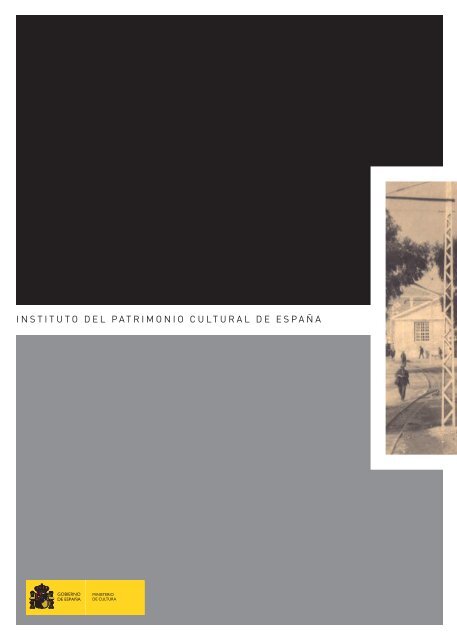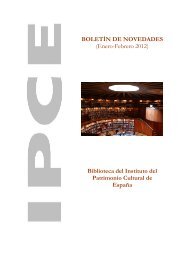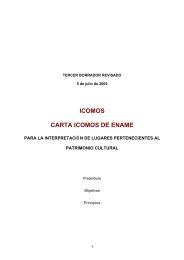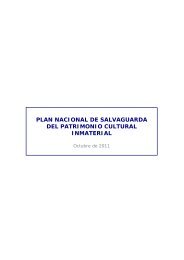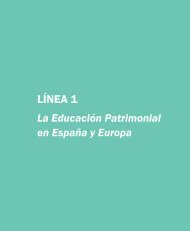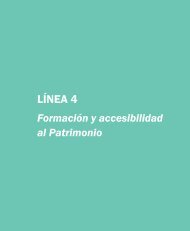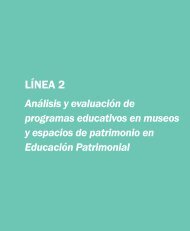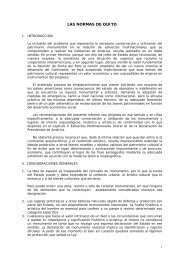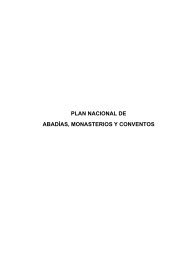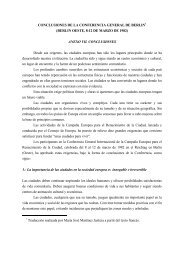EL BIERZO CHARTER FOR THE CONSERVATION OF THE INDUSTRIAL MINERAL HERITAGE
Carta El Bierzo para la conservación del patrimonio industrial minero
Carta El Bierzo para la conservación del patrimonio industrial minero
- No tags were found...
You also want an ePaper? Increase the reach of your titles
YUMPU automatically turns print PDFs into web optimized ePapers that Google loves.
MINISTERIODE CULTURACésar Antonio MolinaMinistro de CulturaMaría Dolores Carrión MartínSubsecretaria de CulturaJosé JiménezDirector General de Bellas Artes y Bienes Culturales
Dentro del Patrimonio Histórico Español los bienes que integran el Patrimonio Industrial se han convertido,desde comienzos del nuevo milenio, en objeto de notable interés por parte de las AdministracionesPúblicas. El texto que aquí se presenta supone un paso adelante en esa política de preservaciónde la memoria industrial, abordando uno los sectores generadores de mayor problemática socioeconómicadentro de la misma: la producción minera.“La Carta de El Bierzo para la Conservación del Patrimonio Industrial Minero” constituye un ejercicio dereflexión sobre los valores culturales propios de los bienes vinculados a la explotación minera de épocaindustrial, presentando asimismo una propuesta metodológica para su preservación y disfrute público.Se trata de un documento que, elaborado por los técnicos del Instituto del Patrimonio Cultural deEspaña, Subdirección dependiente de la Dirección General de Bellas Artes y Bienes Culturales delMinisterio de Cultura, fue presentado en unas jornadas técnicas celebradas en Ponferrada durante elmes de octubre de 2007. En este encuentro, organizado por el Instituto del Patrimonio Cultural deEspaña y la Fundación Estatal Ciudad de la Energía, con la colaboración de la Junta de Castilla y León,estuvieron representadas todas las Comunidades Autónomas, a través de técnicos especializados enPatrimonio Industrial. Dicho texto fue elevado al Consejo de Patrimonio Histórico del 27 de junio de2008, siendo aprobado por el mismo.La Carta de Bierzo supone así, no solo un desarrollo sectorial del Plan Nacional de PatrimonioIndustrial, sino un ejemplo evidente de la coordinación a nivel nacional de las diversas AdministracionesPúblicas competentes en la gestión de los Bienes Culturales.
ZONA ARQUEOLÓGICA DE LAS MÉDULAS. LEÓN.FOTOGRAFÍA CEDIDA POR LA DIRECCIÓN GENERAL DE PATRIMONIO CULTURALDE LA COMUNIDAD AUTÓNOMA DE CASTILLA Y LEÓN.
ONE_INTRODUCTIONHidden in the bowels of the earth, minerals have been considered one of the natural resources mostcovetedby human beings since prehistoric times. In this fashion, charged with symbolic significance(conferred by mythology) or considered exclusively through a lens of economic exploitation, the searchfor them and their management have been revealed over the course of History as one of the human activitiesof greatest impact upon the environment.Starting from the fact that Mining emerges as one of the principal activities of exploitation, being in thepresent day necessary not just for daily life but also for progress, the work of conserving inactive miningexcavations is not merely recommended but is fundamental for the knowledge of the industry, consideringthese vestiges an integral part of our common heritage.This last part of this statement takes on special relevance when we corroborate that in Europe, duringthe final decades of the Twentieth Century, a generalized re-conversion of the mining industry took placewhich separated thousands of people from this activity and left, almost from one day to the next andindependent of the exhaustion of its lodes, the greater part of mining installations on the point of disappearance.While the future conservation of all of them is impossible, it is not impossible to make a selectionof the most representative to catalog them and protect them legally in support of theirconservation, in the same way that today it is indisputable the conservation of Religious or DefensiveHeritage.Moreover, although in bygone days mining installations were considered to disturb the natural environment,today their conservation is seen as an act that guarantees the preservation of the CulturalLandscapes, preservation stimulated by the European Landscape Convention (Florence, 2000).It is therefore urgently necessary that the appropriate administrations in the defense of HistoricalHeritage-the municipalities, the companies, and especially the public and the professional collectiveslinked to the Mining industry-unite forces to establish a first selection of the mining excavations thatshould be conserved and restored for public visits. This initiative, aside from enriching our HistoricalHeritage, will serve, thanks to Cultural Tourism, to establish a minimal sustainable development andwill impede the abandonment and perhaps the desertion of vast territories, encouraging in this fashionthe knowledge of geomineral resources. Resources which since Roman times have held a starring rolein the economy of the Iberian Peninsula, as testified to by the ancient gold mines of Las Médulas, includedin the List of World Heritage Sites of the UNESCO, the mercury mines of Almadén, or the copper excavationsof the Río Tinto. In the same way, Spain has made a significant contribution in theinternationalization and the technological spread of the mining markets.This current document, born in the bosom of the National Plan for Industrial Heritage, does not pretendto approach Mining Heritage circumscribed by the model of pre-industrial production, but only and exclusivelyin the joint context of material and intangible proofs associated with mining excavation in therealm of Industrialization. It therefore concerns a Heritage which possess its own characteristics, withauthentic personality, and therefore subject to an individualized treatment.SPANISH CULTURAL <strong>HERITAGE</strong> INSTITUTE
UNO_INTRODUCCIÓNEscondido en las entrañas de la tierra el mineral ha constituido desde tiempos prehistóricos uno de losrecursos naturales más codiciados por el ser humano. De este modo, cargado de significado simbólico–otorgado por la mitología- o exclusivamente concebido desde un prisma económico de explotación, subúsqueda y gestión se ha revelado a lo largo de la Historia como una de las actividades humanas demayor impacto sobre el medio.Partiendo de que la Minería se erige como una de las principales actividades de explotación, siendo enla actualidad imprescindible no sólo para la vida cotidiana sino también para el progreso, la labor deconservar explotaciones mineras sin actividad, no sólo es recomendable sino fundamental para el conocimientode la industria, considerándose estos vestigios parte integrante de nuestro patrimonio común.Especial relevancia adquiere esto último cuando comprobamos que en Europa, durante las décadas finalesdel siglo XX, se produjo una reconversión generalizada del sector minero que apartó de esta actividada miles de personas y dejó, casi de un día para otro e independientemente del estado deagotamiento de sus filones, en trance de desaparición, la mayor parte de las instalaciones mineras.Pese a que la conservación futura de la totalidad de éstas resulta imposible, no lo es el hacer una selecciónde las más representativas para catalogarlas y protegerlas legalmente en pro de su conservación,de la misma manera que hoy en día es indiscutible la conservación del patrimonio religioso o defensivo.Además, aunque antaño se considerase que las instalaciones mineras perturbaban el medio natural,hoy en día la conservación de las mismas se percibe como un acto que garantiza la preservación de losPaisajes Culturales, preservación impulsada por la Convención Europea del Paisaje (Florencia, 2000).Urge, por tanto, que las administraciones competentes en la defensa del Patrimonio Histórico, los municipios,las empresas, sobre todo las públicas y los colectivos profesionales vinculados a la Minería aúnenesfuerzos para establecer una primera selección de las explotaciones mineras que deben serconservadas y rehabilitadas para su visita pública. Esta iniciativa a parte de enriquecer nuestroPatrimonio Histórico, servirá, gracias al Turismo Cultural, para establecer un mínimo desarrollo sostenidoe impedirá el abandono y quizás la desertización de amplios territorios, favoreciendo asimismo elconocimiento de los recursos geomineros. Unos recursos que desde tiempos romanos han desempeñadoun papel protagonista en la economía de la Península Ibérica, tal como atestiguan los antiguos yacimientosauríferos de las Médulas, incluidos en la Lista del Patrimonio Mundial de la UNESCO, lasminas de mercurio de Almadén o las explotaciones de cobre de Río Tinto. Del mismo modo, España harealizado una notable contribución en la difusión tecnológica y en la internacionalización de los mercadosmineros.El presente documento, nacido en el seno del Plan Nacional de Patrimonio Industrial, no pretendeabordar el Patrimonio Minero circunscrito al modelo de producción preindustrial, sino única y exclusivamenteel conjunto de evidencias materiales e inmateriales vinculadas a la explotación minera en elámbito de la Industrialización. Se trata pues de un Patrimonio que posee unas características propias,con auténtica personalidad, y por tanto susceptible de un tratamiento individual.INSTITUTO D<strong>EL</strong> PATRIMONIO CULTURAL DE ESPAÑA
SALINAS DE OJOS NEGROS. TERU<strong>EL</strong>.FOTOGRAFÍA CEDIDA POR LA DIRECCIÓN GENERAL DE PATRIMONIO CULTURALDE LA COMUNIDAD AUTÓNOMA DE ARAGÓN.MINA PALAZU<strong>EL</strong>OS, JAÉN.FOTOGRAFÍA CEDIDA POR LA ASOCIACIÓN COLECTIVO PROYECTO ARRAYANES.
POZO SANTA ANNIE. MINAS LA TORTILLA, JAÉN.FOTOGRAFÍA CEDIDA POR LA ASOCIACIÓN COLECTIVO PROYECTO ARRAYANES.POZO CASTILLETE Y CASA DE MÁQUINAS D<strong>EL</strong> POZO SAN LUIS, SAMUÑO.CONCEJO DE LANGREO, ASTURIAS. FOTOGRAFÍA CEDIDA POR LA DIRECCIÓN GENERALDE PATRIMONIO CULTURAL DE LA COMUNIDAD AUTÓNOMA D<strong>EL</strong> PRINCIPADO DE ASTURIAS.
TWO_<strong>THE</strong> CONCEPT <strong>OF</strong> MINING <strong>HERITAGE</strong>Paradoxically, I plunge into an industrial sector which after undergoing a profound transformation in thelast decade of the Twentieth Century shows today a bullish economic tendency, traditional MiningHeritage, that is to say, the Heritage linked to the excavation of carbon, lead, salt, and other natural resources,has become an epicenter of more than few national and international forums. At these meetings,hinging around the concerns of citizens or the Public Administrations themselves, abandonment,deterioration, and loss are concepts that center and motivate the discourse of safeguarding MiningHeritage.Making a detailed analysis of this discourse one can appreciate that it has spun and spins, in some casesstill, around two axes:1. The value of Mining Heritage as a fossil evocating a vanished time. Time interpreted in the context ofexploitation and camaraderie, a time of initiation, a time of technological progress and environmentaldestruction, in short, Time.2. The value of Mining Heritage as a regenerator of communities whose management and development wereinextricably linked to the mines and with the close of these same have been condemned to disappearance.As have been demonstrated, the great conservation projects and efforts begun by the AutonomousCommunities, Provinces, and Municipalities, Mining Heritage goes beyond this simple conception.When we speak of pit mines, passages, wells, archives of the mining or railway companies, we don'tonly refer to the remains of a great wreck or collapse, we find ourselves before a true document forthe study of History, of History written with capital charters. We are before a heritage with its own personalityderived from a complex of values:– Historic Value– Material Values, Moveable and Immoveable– The Values of the Technological Processes– Environmental Values– Anthropological/Ethnological Values– Aesthetic ValuesThe existence of these values, which confer their own personality to Mining Heritage, is what determinesthe need to arbitrate protocols for proceeding or methodology guidelines on the part of the PublicAdministrations, which permit the guidance of the proceedings in the mine environment.THREE_METHODOLOGY <strong>FOR</strong> INTERVENTION IN MINING COMPLEXESInventoryIt is considered necessary to undertake an inventory of the Industrial Mining Heritage as a first requisiteto be able to plan its protection and promotion. In it, the elements and complexes subject to protectionand guardianship must be identified.In order for said Inventory to be undertaken with the necessary scientific rigor, it must be approached fromthe independence of interdisciplinary criteria, elaborating beforehand a methodology, a language, and a codeof criteria for the common interpretation and valuation between the distinct disciplines and agents involved,in such a way that the objectivity, coherence, durability, and accessibility of the information collected isguaranteed.In the task of inventorying the works associated with any mining complex one must consider, at the veryleast, the inclusion of the following data:– Historic and archeological study of the complex. Geographic delimitation of the complex.
DOS_<strong>EL</strong> CONCEPTO DE PATRIMONIO MINEROInserto paradójicamente en un sector industrial que tras vivir una profunda transformación en la últimadécada del siglo XX manifiesta en la actualidad una tendencia económica alcista, el Patrimonio Minerotradicional, es decir, el vinculado a la explotación del carbón, el plomo, la sal y otros recursos naturales,se ha convertido en el epicentro de no pocos foros nacionales e internacionales. En estas reuniones, articuladasen torno a la preocupación de los ciudadanos o de las propias Administraciones Públicas,abandono, deterioro y pérdida son conceptos que centran y motivan el discurso de salvaguarda delPatrimonio Minero.Realizando un análisis detallado de este discurso puede apreciarse que el mismo ha girado y gira, enalgunos casos todavía, alrededor de dos pilares:1. El valor del Patrimonio Minero como fósil evocador de un tiempo desaparecido. Tiempo interpretadoen clave de explotación y camaradería, tiempo iniciático, tiempo de progreso tecnológico y destrucciónmedioambiental, en suma, Tiempo.2. El valor del Patrimonio Minero como regenerador de comunidades cuya gestación y desarrollo seprodujo en torno a la mina y que con el cierre de la misma se han visto condenadas a la desaparición.Como están demostrando los grandes proyectos de conservación y puesta en valor emprendidos porComunidades Autónomas, Provincias y Municipios, el Patrimonio Minero va mucho más allá de estasimple concepción. Cuando hablamos de bocaminas, galerías, pozos, archivos de las compañías mineraso ferrocarriles no nos referimos únicamente a los restos de un gran naufragio, nos encontramosante un verdadero documento para el estudio de la Historia, de la Historia con mayúsculas. Estamosfrente a un Patrimonio con personalidad propia derivada de un conjunto de valores:– Valores Históricos– Valores Materiales, muebles e inmuebles– Valores de los procesos tecnológicos– Valores Medioambientales– Valores Antropológicos / Etnológicos– Valores EstéticosLa existencia de estos valores, que confieren una personalidad propia al Patrimonio Minero, es la quedetermina la necesidad de arbitrar protocolos de actuación o directrices metodológicas por parte de lasAdministraciones Públicas, que permitan guiar las actuaciones en el entorno de la mina.TRES_METODOLOGÍA DE INTERVENCIÓN EN COMPLEJOS MINEROSInventarioSe considera necesaria la realización de un Inventario del Patrimonio Industrial Minero como primerrequisito para poder planificar su protección y promoción. En él deberán identificarse los elementos yconjuntos susceptibles de protección y tutela.Para que dicho Inventario sea realizado con el necesario rigor científico deberá abordarse desde la independenciade criterios interdisciplinares, elaborando previamente una metodología, un lenguaje y un códigode criterios de interpretación y valoración comunes entre las distintas disciplinas y agentesinvolucrados, de modo que se garantice la objetividad, la coherencia, la durabilidad y la accesibilidad de lasinformaciones recogidas.En la labor de inventariar los bienes vinculados a cualquier complejo minero habrá de considerarse, almenos, la inclusión de los siguientes datos:– Estudio histórico y arqueológico del complejo. Delimitación geográfica del mismo.
BARRU<strong>EL</strong>O DE SANTILLÁN, PALENCIA. FOTOGRAFÍA CEDIDA POR LA DIRECCIÓN GENERALDE PATRIMONIO CULTURAL DE LA COMUNIDAD AUTÓNOMA DE CASTILLA Y LEÓN.CASTILLETE, CASA DE MÁQUINAS Y CHIMENEAS DE PEDRERAS VIEJAS. MAZARRÓN, MURCIA.FOTOGRAFÍA CEDIDA POR LA DIRECCIÓN GENERAL DE B<strong>EL</strong>LAS ARTES Y BIENES CULTURALESDE LA COMUNIDAD AUTÓNOMA DE LA REGIÓN DE MURCIA.
CASTILLETE MINA HERRERA, SABERO. LEÓN. FOTOGRAFÍA CEDIDA POR LA DIRECCIÓNGENERAL DE PATRIMONIO CULTURAL DE LA COMUNIDAD AUTÓNOMA DE CASTILLA Y LEÓN.
– Location of each of the elements that comprise the mining complex, including the real and moveableproperty, as well as Documental Heritage from the archives.– Legal regimen of the works that make up the mining complex.– State of conversation. Pathological analysis.– Anthropological/ethnographic study.SelectionHaving established the general overview one must select the elements of unique relevance and applythe appropriate degree of protection to each case in function of the municipal, autonomous, state, andworld legislative regulations.The criteria of application will be:– The historical authenticity.– The representative typology.– The absolute and relative antiquity in terms of typology or technique.– The state of conservation.– The integrity of its cultural identity and typological features.– The historic significance.– The relation of the property and of the installations with the community in which it is a part.– The possibilities of managing the mining complex by the community which owns it, guaranteeing someminimums of sustainability.Legal ProtectionLegal protection of the real and personal property that comprise them is imperative for the conservationof mining complexes. This protection will principally be effected through the figures established to thiseffect in the Historic or Cultural Heritage legislation, the Environmental Protections, and the UrbanZoning Restrictions. It is necessary that the Local Administrations contemplate the conservation ofIndustrial Mining Heritage in their urban planning. For their part, the Public Administrations must protectthe most relevant elements of this Heritage through the corresponding declarations of Works ofCultural Interest or other figures of protection.InterventionIntervention must be conceived as the result of a prior process of investigation, undertakenthrough tools such as Master Plans, Preliminary Studies, or Viability Studies. These instrumentswill permit approaching the actuations upon the Mining Heritage with the adequate guarantees,founded on a solid knowledge of the Work and from a base of strategies that have been properlyplanned at all levels (technical, manageability, usability, etc.)In the design of the intervention, the combination of activities associated with the enhancement of theparticular elements of the complex, as well as the environmental-landscape repercussions of the same,must be considered.As much as possible, that is to say, within the limits that allow us to safeguard the identity, integrity, andauthenticity of the cultural Works, one can opt to grant the mining complex-for the sake of a greater socialprofitability and sustainability for the project-with uses compatible with the enhancement of its statusas Heritage.Access to the interior of the mine, motivated by the observation of natural processes-mineralized levelsorfor the desire to have a life experience, must in all cases be realized after the establishment of somesafety minimums, with the limits imposed by the conservation. This safety will be guaranteed if thecombination of precepts which comprise it were included or incorporated in the legal regulations in effect,execution of the same being the responsibility of technicians who are specialists in this area.
CARGADERO DE M<strong>EL</strong>ILLA.FOTOGRAFÍAS CEDIDAS POR LA DIRECCIÓN GENERAL DE CULTURA DE LA CIUDAD DE M<strong>EL</strong>ILLA.
DisseminationAmong the guiding principles of the work of conservation of Industrial Mining Heritage must be the possibilityof enhancement of the same.If a mine opens its doors to the public, that is to say, if it makes sense among other things the preservationof its decaying nature, it is because the citizenry shows an interest in crossing its threshold.For this reason, the planning of educational and communication programs that facilitateconceptual access to the setting and content of the mining complex is fundamental, adopting themodel that the appropriate Administration deems most suitable: mining museums, the museumizationof mines, mining parks, cultural parks, heritage parks, etc.To explain Industrial Mining Heritage and sensitize the public about the relevance of its special naturethroughexpositions, publications, conferences, etc.-must be viewed as obligatory activities on the partof the public powers, especially when the aesthetic transformation of time and space, characteristic ofthe contemporary world, push social desire in the same direction.Preventative Conservation and MaintenanceThe work of conservation and restoration of the elements of the mine must be planned considering itsnatural geological particularities (continual inundations, collapses, difficulties for environmental controls,etc.). The work of preventative conservation and maintenance will be essential for the effectivefunctioning of the mining installation.F OUR_CONCLUSIONSIn constant conflict with the passage of time, the maintainers of Heritage have managed to elevate thecombination of real and physical property, of physical and intangible nature, associated with Mining activitiesduring the period of Industrialization to the place it merits, after decades of neglect.Historic, aesthetic, anthropologic and environmental values support the conception of Mining IndustrialHeritage as a source of knowledge for the study of History, having allowed this in the end to elaboratemanagement projects and strategies of an integrated nature for said Heritage.In this way, and despite the very concept of expiry which thrums beneath the creation of the mine, theidea of transferring perpetuity to the material and intangible elements of the same-granting them a newuse or simply evidencing the social value inherent in their status as Heritage-must be the engine of thepolitics of investigation, conservation, and dissemination designed by the Public Administrations.Administrations which, guarantors of the conservation and enrichment of the Heritage, by constitutionalmandate, must design their activities in the scope of the mine keeping as principle objectives:– The exhaustive knowledge of the mine and its environment, natural and cultural.– The legal protection of the elements that make up the complex of the mining excavation.– The conservation of the most notable elements of the mining complex.– The involvement and active participation of the communities or groups of people involved in the enhancementof the mine as well as its maintenance.Like the work clothes abandoned in the pit mines, defying the passage of time, Industrial MiningHeritage, lethargic beneath the weight of the social conflicts that produced its neglect, must be resurrectedfrom the silence which still enshrouds it. Many are the projects and initiatives set into motion togive voice back to the Heritage hidden inside the earth and this Charter doesn't pretend to be more thana ray of light in the darkness of that mine.
DifusiónEntre los principios rectores de la labor de conservación del Patrimonio Industrial Minero debe encontrarsela posibilidad de puesta en valor del mismo.Si una mina abre sus puertas al público, es decir, si tiene sentido entre otras cosas la preservación desu naturaleza perecedera, es porque la ciudadanía muestra interés por atravesar el umbral de la misma.Por este motivo, resulta fundamental la planificación de programas educativos y comunicativos quefaciliten el acceso conceptual al entorno y contenido del complejo minero, adoptando el modelo que laAdministración Competente determine: museos mineros, musealización de minas, parques mineros,parques culturales, parques patrimoniales, etc.Interpretar el Patrimonio Industrial Minero y sensibilizar a la población sobre la relevancia de su especialnaturaleza –a través de exposiciones, publicaciones, congresos, etc- habrán de considerarse tareas deimprescindible cumplimiento por parte de los poderes públicos, máxime cuando la transformación estéticadel tiempo y del espacio, característica del mundo contemporáneo, impulsan el deseo social enidéntica dirección.Conservación Preventiva y MantenimientoLos trabajos de conservación y restauración de los elementos de la mina deben planificarse considerandosus particularidades naturales –geológicas- (constantes inundaciones, derrumbamientos, dificultadespara el control medioambiental, etc). Serán imprescindibles para el buen funcionamiento delas instalaciones mineras las labores de conservación preventiva y el mantenimiento.CUATRO_CONCLUSIONESEn constante litigio con el paso del tiempo, los gestores del Patrimonio han conseguido elevar al lugarque corresponde, tras décadas de olvido, el conjunto de bienes muebles e inmuebles, de naturalezamaterial e inmaterial, vinculados a la explotación minera durante el periodo de la Industrialización.Valores históricos, estéticos, antropológicos y medioambientales avalan la concepción del PatrimonioMinero Industrial como fuente de conocimiento para el estudio de la Historia, habiendo permitido estoúltimo elaborar proyectos y estrategias de gestión para dicho Patrimonio de carácter integral.De este modo y pese al propio concepto de caducidad que late tras la creación de la mina, la idea deconferir perpetuidad a los elementos materiales e inmateriales de la misma -dotándoles de un nuevouso o simplemente evidenciando el valor social inherente a su condición patrimonial- debe constituir elmotor de las políticas de investigación, conservación y difusión diseñadas por las AdministracionesPúblicas. Unas Administraciones que, garantes de la conservación y enriquecimiento del Patrimonio,por mandato constitucional, han de diseñar sus actuaciones en el ámbito de la mina teniendo comoprincipales objetivos:– El conocimiento exhaustivo de la mina y su entorno, natural y cultural.– La protección jurídica de los elementos que componen el complejo minero de explotación.– La conservación de los elementos más significativos del complejo minero.– La implicación y participación activa de las comunidades o grupos humanos en los que se inserta elcomplejo minero para la puesta en valor del mismo, así como para su mantenimiento.Como la indumentaria de trabajo abandonada en las bocaminas, desafiando el paso de los años, elPatrimonio Industrial Minero, aletargado bajo el peso de los conflictos sociales que provocaron su olvido,ha de ser rescatado del silencio que todavía lo envuelve. Muchos son los proyectos e iniciativaspuestas en marcha para devolver la palabra al patrimonio escondido en el interior de la tierra y la presenteCarta no pretende sino convertirse en un haz de luz en la oscuridad de esa mina.
TRABAJO EN LA MINA. ISLAS CANARIAS. FOTOGRAFÍA CEDIDA POR LA DIRECCIÓN GENERALDE COOPERACIÓN Y PATRIMONIO CULTURAL DE LA COMUNIDAD AUTÓNOMA DE CANARIAS.
Esta publicación se terminó de imprimiren los talleres de Gráficas XXXXXXen el mes de marzo de 2009


